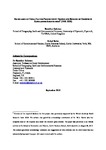Six Decades of Total Factor Productivity Change and Sources of Growth in Bangladesh Agriculture (1948–2008)
| dc.contributor.author | Rahman, Sanzidur | |
| dc.contributor.author | Salim, R | |
| dc.date.accessioned | 2015-12-24T16:54:32Z | |
| dc.date.available | 2015-12-24T16:54:32Z | |
| dc.date.issued | 2013-06-01 | |
| dc.identifier.issn | 0021-857X | |
| dc.identifier.issn | 1477-9552 | |
| dc.identifier.uri | http://hdl.handle.net/10026.1/4000 | |
| dc.description.abstract |
This study applies the Färe–Primont index to calculate total factor productivity (TFP) indices for agriculture in 17 regions of Bangladesh covering a 61-year period (1948–2008). It decomposes the TFP index into six finer components (technical change, technical-, scale- and mix-efficiency changes, residual scale- and residual mix-efficiency changes). Results reveal that TFP grew at an average rate of 0.57% p.a. led by the Chittagong, Rajshahi, Rangpur, Dinajpur and Noakhali regions. TFP growth is largely powered by technological progress estimated at 0.74% p.a. Technical efficiency improvement is negligible (0.01% p.a.) due to stagnant efficiency in most of the regions. Decline in scale efficiency is also negligible (0.01% p.a.), but the decline in mix efficiency is high at 0.19% p.a. Decomposition of the components of TFP changes into finer measures of efficiency corrects the existing literature’s blame of a decline in technical efficiency as the main cause of poor TFP growth in Bangladesh. Among the sources, farm size, R&D investment, extension expenditure and crop specialisation positively influenced TFP growth, whereas the literacy rate had a negative influence on growth. Policy implications include encouraging investment in R&D and extension, land reform measures to increase average farm size, promotion of Green Revolution technology and crop diversification. | |
| dc.format.extent | 275-294 | |
| dc.language | English | |
| dc.language.iso | English | |
| dc.publisher | Wiley-Blackwell | |
| dc.subject | Bangladesh | |
| dc.subject | Fare-Primont TFP index | |
| dc.subject | technical-, scale- and mix-efficiency changes | |
| dc.subject | technical changes | |
| dc.title | Six Decades of Total Factor Productivity Change and Sources of Growth in Bangladesh Agriculture (1948–2008) | |
| dc.type | journal-article | |
| dc.type | Article | |
| plymouth.author-url | https://www.webofscience.com/api/gateway?GWVersion=2&SrcApp=PARTNER_APP&SrcAuth=LinksAMR&KeyUT=WOS:000318988700001&DestLinkType=FullRecord&DestApp=ALL_WOS&UsrCustomerID=11bb513d99f797142bcfeffcc58ea008 | |
| plymouth.issue | 2 | |
| plymouth.volume | 64 | |
| plymouth.publication-status | Published | |
| plymouth.journal | Journal of Agricultural Economics | |
| dc.identifier.doi | 10.1111/1477-9552.12009 | |
| plymouth.organisational-group | /Plymouth | |
| plymouth.organisational-group | /Plymouth/Faculty of Arts, Humanities and Business | |
| plymouth.organisational-group | /Plymouth/Users by role | |
| dc.publisher.place | UK | |
| dc.identifier.eissn | 1477-9552 | |
| dc.rights.embargoperiod | Not known | |
| rioxxterms.versionofrecord | 10.1111/1477-9552.12009 | |
| rioxxterms.licenseref.uri | http://www.rioxx.net/licenses/all-rights-reserved | |
| rioxxterms.type | Journal Article/Review |


